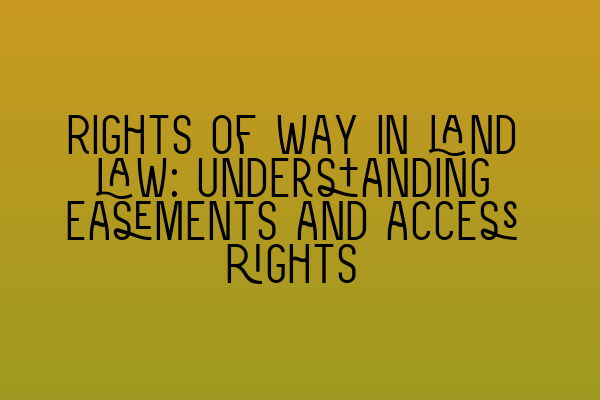Rights of Way in Land Law: Understanding Easements and Access Rights
When it comes to property law, one key aspect that often arises is the issue of rights of way. Understanding easements and access rights is crucial for property owners, as it can significantly impact the use and enjoyment of their land. Whether you are considering purchasing a property, dealing with a dispute, or simply want to expand your knowledge of land law, this comprehensive guide will provide you with all the essential information you need to know.
What are Easements?
An easement is a legal right granted to a person or entity, allowing them to use and access another person’s land for a specific purpose. It essentially creates a legal interest in the land that benefits the holder of the easement. Common examples of easements include:
- Right of way: The right to pass over a specific pathway or road on another person’s land.
- Right to light: The right to receive natural light through a specified opening, such as a window.
- Right of support: The right to have the neighboring land provide physical support to a building or structure.
- Right to drain water: The right to drain water onto another person’s land.
Easements can be created in several ways, such as through an express grant, implied grant, or by prescription. It is important to note that easements can be registered against the title of the land, ensuring their enforceability.
Types of Rights of Way
Rights of way are among the most common easements encountered in land law. They provide individuals with the legal right to pass over or use a particular route in order to access another property or area of land. Here are some of the main types of rights of way:
- Private Rights of Way: These are rights of way that are granted to specific individuals or properties, generally through a legal agreement or deed.
- Public Rights of Way: These are rights of way that are available to the general public and are established by law or long-standing custom. They may include footpaths, bridleways, or byways.
- Prescriptive Rights of Way: These are rights of way that are acquired by continuous and uninterrupted use of a specific route for a certain period of time, typically 20 years, without the need for a formal agreement.
Each type of right of way carries its own set of legal implications, and it is important to fully understand the rights and restrictions associated with them.
Easement Disputes and Legal Challenges
While easements may be beneficial for property owners, they can also give rise to disputes and legal challenges. Common issues that may arise include:
- Interference with the right of way: If someone obstructs or interferes with the use of a right of way, it can lead to strained relationships and potential legal action.
- Expansion of the right of way: Disputes may arise when a property owner tries to extend or modify an existing right of way beyond its original scope.
- Termination of the right of way: There may be situations where the right of way is no longer necessary or relevant, leading to discussions regarding its termination.
In cases of easement disputes, it is essential to seek legal advice from an experienced property solicitor who can help resolve the issue and protect your rights.
Protecting Your Rights: Legal Advice and Documentation
When it comes to easements and access rights, it is essential to seek professional legal advice to ensure that your rights are properly protected. A property solicitor can assist you in:
- Drafting and reviewing easement agreements
- Negotiating the terms of the right of way
- Resolving easement disputes and conflicts
- Registering easements against the title of the land to ensure their enforceability
By working with a trusted property solicitor, you can have peace of mind knowing that your rights are safeguarded and any potential issues are dealt with effectively.
Conclusion
Rights of way and easements are essential aspects of property law that can have a significant impact on landowners and property transactions. Understanding the various types of rights of way, the creation and enforcement of easements, and the potential legal challenges that may arise is crucial for anyone involved in property ownership or dealings.
At SQE Property Law & Land Law, we are here to help you navigate the complexities of land law and provide comprehensive legal advice tailored to your specific needs. Contact us today to discuss your property law concerns and let our team of experienced property solicitors guide you through the intricacies of easements and access rights.
Related Articles:
- Legal challenges in property transactions: A comprehensive guide
- Dominate Property Law Questions: Avoiding Common Pitfalls
- Land Law Revision Tips: Ace Your Exam Preparation
- Mortgages and land law: Essential considerations for property transactions
- Environmental Ethics in Land Law: Balancing Development and Sustainability
